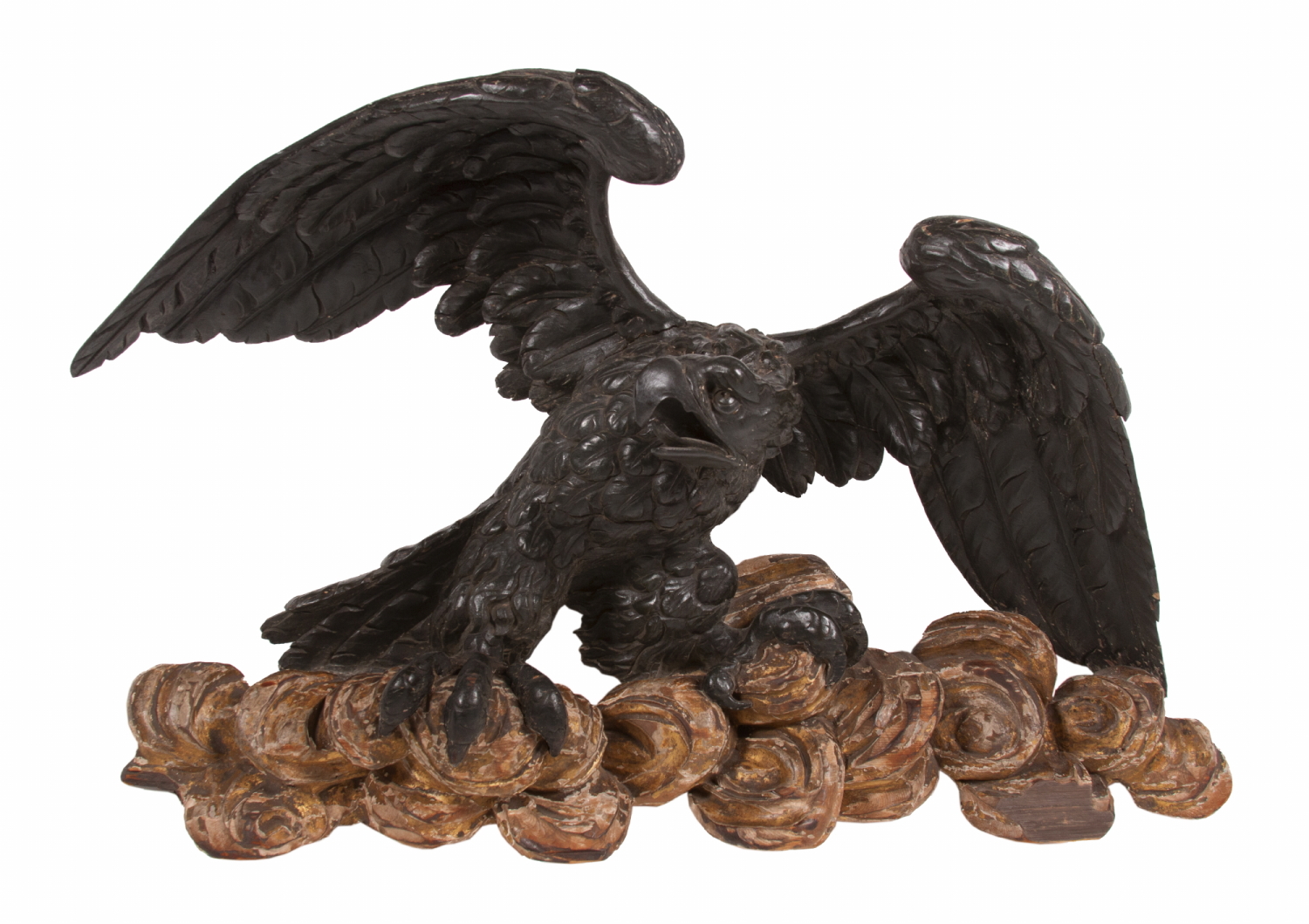
| |
BOLD, EBONIZED CARVING OF AN AMERICAN EAGLE, EXPERTLY DEVELOPED & DRAMATICALLY POSED, AS IF EMERGING REVERENT ON A BED OF CLOUDS, circa 1785 – 1820 |
| |
|
| Dimensions (inches): |
36" w x 23" tall x 17"d |
| Description: |
|
Hand-carved American eagle with ebonized & gilded surface, expertly developed and dramatically portrayed. The concept of portraying the national symbol of America upon a bed of clouds, in a warlike stance, suggests its unveiling to the world, victorious & reverent, one wing arched high in defense of liberty.
Made sometime within the Federal period, between roughly 1885 and the 18-teens, note the voluptuous nature of its curved neck, brow, tongue, and beak, and how they complement one-another around a piercing, deep-set eye. Also note how these things are stylistically reflected in the bulbous wrists of the wings, large talons, and prominent covert feathers.
If the use of clouds as a perch seems an unusual one for the American eagle, know that they are a consistent element throughout the earliest known depictions of eagles in American patriotic imagery, including all versions of The Great Seal of the United States. They appear—without eagles—in both the first and second, unsuccessful submissions of it to Continental Congress by Francis Hopkinson of New Jersey in 1780, as well as the final submission on June 20th, 1782 by Charles Thomson of Pennsylvania, approved by Congress on the same day.
Clouds also appear in the design of The Seal of The President of the Congress of the Confederation. This legislative body was simply the outgrowth of Continental Congress, meaning that which existed following the March 1st, 1781 acceptance of the Articles of Confederation. The seal of its president was in active use between approximately 1782 - 1789, until the United States Constitution was ratified and Washington assumed the White House.
According to Thomson, former Sons of Liberty organizer, a close friend and ally of Benjamin Franklin, the reason for including clouds was to illustrate a new nation emerging through them. Thomson was not a delegate, but instead served as Secretary of both Continental Congresses throughout their existence. In this capacity he was keeper of the seal.
Swirled clouds, of almost identical form to those present on this carving, appear on the original die produced for the Great Seal of the United States, in active use from September, 1782 – 1841. On the die (now at the National Archives) one can see the engraver’s interpretation of Thomson’s rough sketch, with the head of the great bird reaching into the ring of clouds into the illustrious rays of a bright sun, with 13 six-pointed stars emblazoned upon it, arranged in a six-pointed, “Great Star” pattern (star made out of stars), to signify the 13 colonies. All of the same components are still present today on the Great Seal, modernized, but with no earthshattering differences. Another notable depiction survives in one of the earliest and most famous renditions of the device, on a painting long displayed beside the pew of George Washington in St. Paul’s Episcopal Chapel at Trinity Church in lower Manhattan, the eldest house of worship that still exists in the city.
Although clouds have been an element of the various versions the 18th century to the 21st, their inclusion as a perch for carved versions of the American eagle are highly unusual, and thus especially notable in this early example.
The carving is unattributed. With all of the research compiled on so many objects in the world of American decorative arts, one would think that a plethora of knowledge would be accessible on carved American eagles of the 18th and 19th centuries. Unfortunately this is simply not so. Most of what has been written is centered on carvers such as John Haley Bellamy (1836-1914), who sold his first around 1870. Very little has been assembled on earlier carvers of eagles, such a William Rush of Pennsylvania (1766-1833) and Samuel McIntire of Massachusetts (1757-1811). McIntyre’s work is easier to recognize, based upon some of the notable features in documented examples. Those attributed to Rush, considered perhaps the greatest American carver of the 18th century, are plentiful enough, but are so inconsistent in style that asserting a new attribution from published images is extremely difficult. Beyond these two men, the names of other carvers in America’s earliest periods are extraordinarily scant.
McIntyre was a folk carver. Rush was decidedly not, and though his much-celebrated carvings of human and human-like figures are, in general, nothing short of masterful, the eagles attributed to his hand are not of comparable quality.
The carving that is the subject of this narrative is more expertly accomplished and better developed than any early example I have seen attributed to Rush. It may simply be that those identified to Rush were ones that required urgency and thus exhibit less detail. Though he was undoubtedly both, Bellamy considered himself more of an entrepreneur than an artist. Most artists who sell their work for a living have to strike some sort of balance. Bellamy’s masterpieces are, as a rule, rather different than the bread-and-butter work that put food on his table, but at least they bear enough commonalities to make attributions. Rush’s are far more difficult in that capacity.
In spite of who the carver may have been, this is one of the best early examples of a carved American eagle that I have encountered in the marketplace for early American decorative arts, with unusual symbolism, exceptionally bold form, excellent craftsmanship, and attractive, ebonized surface.
Condition: Report to follow. Please inquire. |
|
|
| |
|
| Primary Color: |
black, gold |
|
| Earliest Date: |
1785 |
|
| Latest Date: |
1820 |
|
| For Sale Status: |
Available |
|
| Price |
Please call (717) 676-0545 or (717) 502-1281 |
|
| E-mail: |
info@jeffbridgman.com |
|
 |
|
Page Views:... 1904 |
|


